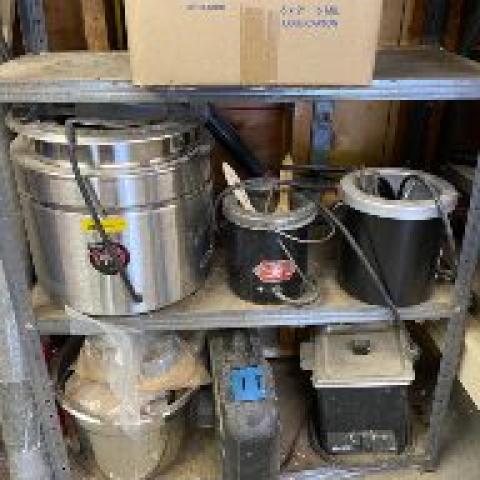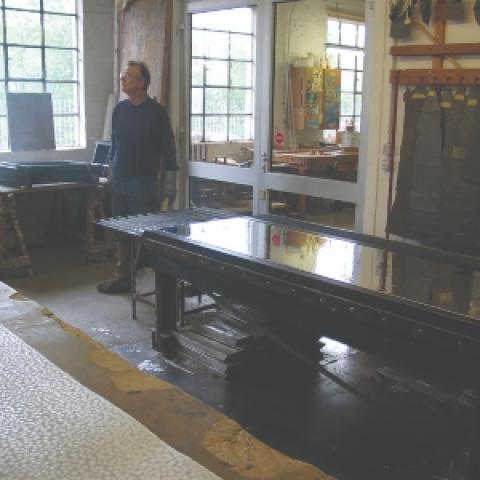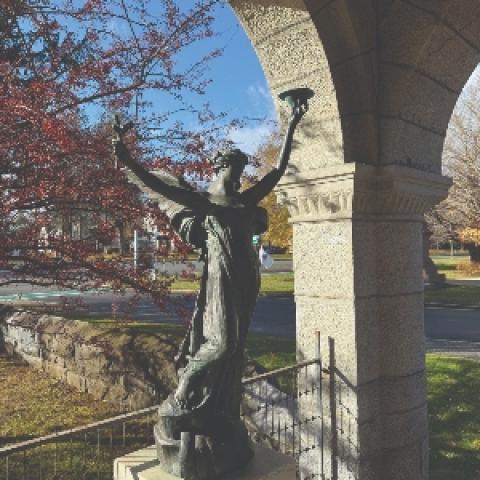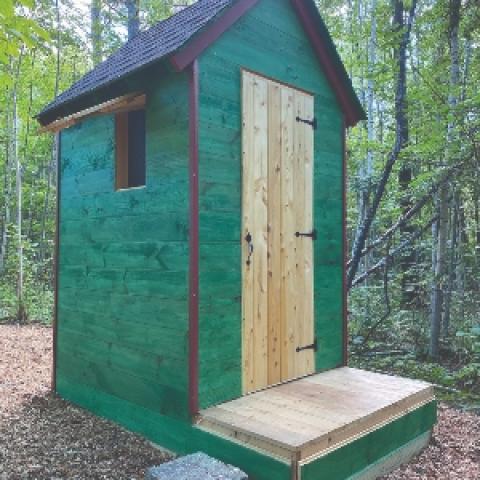
One size fits all.
As a plus-sized organ guy whose shoulders are four or five inches wider than an airplane seat, I always sit in an aisle seat so I do not have to crunch up against my neighbor. Instead, I am regularly clobbered by the flight attendant’s cart and the sloppiest of my fellow passengers as they negotiate the trek to the restroom. Years ago, on a flight to who knows where, I was seated next to a young woman who was sitting with her legs curled under her on her seat. I marveled at her flexibility, and when we stood to deplane, I realized she was under five feet tall and weighed a hundred pounds or less. We had paid the same price for our seats, and she was sitting perfectly comfortably while I was squeezed into my seat like toothpaste in a tube. Hats, mittens, or leggings might be sold as one-size-fits-all, but I know that really means they will be loose on small people and tight on large people.
So it goes with education. Modern public schools are governed by the demands of standardized testing as if every child in America needs an identical education. My son Chris teaches English as a second language in an urban public high school where his students are first- or second-generation immigrants who speak Spanish, Vietnamese, and Chinese at home, as it is typical that their parents do not speak English. These kids cannot be expected to thrive if they are being held to the same standards as their classmates who grew up speaking nothing but English. It is a heinous form of discrimination.
My other son Mike did not finish high school but worked in a succession of bicycle shops as a teenager and graduated to specialized piping, building the complex networks of tubing in university research labs. When he told me he had learned to do internal welding on eighth-inch stainless steel tubing, I knew he was going to be okay. He has now had a fifteen-year career with an architectural fabrication firm where he builds high-end signage with complex electrical systems, like the miles of LED displays that encircle the guitar-shaped Hard Rock Hotel in Hollywood, Florida. He built and installed all the road signs for Terminal B of Logan Airport in Boston (“Central Parking, Next Left”), interior signs for Madison Square Garden including the jumbotron, and the new Whitney Museum of American Art in New York City. You might think that Mike is disadvantaged because he did not have algebra or calculus in high school, but he uses more complex mathematics at his workstation every day than many of us do in a lifetime.
I had an industrial arts class in middle school where I learned to use a stationary shear, a metal brake, rollers, and rivets making a half-pipe-shaped, sheet-metal firewood caddy with decorative black iron legs and hoop handle. That gold-painted beauty stood next to the fireplace in my parents’ home until they moved into assisted living forty years later. I had algebra in high school, but I sure spent a lot of days in my career as an organ builder developing the metal-working skills I learned when I was thirteen.
In his book Shop Class as Soulcraft (Penguin Press, 2009), Matthew Crawford wrote about the dwindling of public school industrial arts education as schools focused more on standardized testing and achieving 100% college admissions. The second paragraph of his book’s introduction begins, “The disappearance of tools from our common education is the first step toward a wider ignorance of the world of artifacts we inhabit.” He goes on to describe how modern engineering focuses on “hiding the works” by designing machines so that you cannot tell how they are put together or how they work. Open the hood of a new car, and you can hardly tell there is an engine in there, and to keep our precious hands clean, some newer Mercedes models do not have dipsticks, as if it is not the owner’s responsibility to pay attention to whether there is oil in the engine.
In 1917, Congress passed the Smith-Hughes Act that provided funding for manual training in public schools, both as part of general education and as designated vocational schools. Crawford cites that starting around 1980, 80% of public high school shop programs began to disappear.1 Throughout the book, he makes the case that while some people flourish practicing law or managing businesses, many people are cut out to work with their hands, gaining the satisfaction of making or repairing something, what he calls “primary work.” He points out that surgery is a meeting of intellectual and manual disciplines. Standardized testing implies that a kid who is destined to be a plumber needs the same foundation as one who will be a musician or a corporate executive. Who can tell the future of a ten-year-old? You can’t. You provide all children with an education that includes academics, the arts and humanities, the industrial world, and sports, and hope that each child will be captivated by something—liberal arts for teenagers.
Simply reading the table of contents of Crawford’s book gives an overview of his point of view regarding the manual arts: “A Brief Case for the Useful Arts;” “The Separation of Thinking from Doing;” “To Be Master of One’s Own Stuff;” “The Education of a Gearhead;” “The Further Education of a Gearhead: From Amateur to Professional;” “The Contradictions of the Cubicle;” “Thinking as Doing;” “Work, Leisure, and Full Engagement.” As an organ builder, I have spent much of my life negotiating and contemplating the differences between blue- and white-collar work, and I recommend this book as a good read with lively writing and philosophical musings from the life of a literary motorcycle mechanic.
Early in my career, living and working in Oberlin, Ohio, one of our friends taught diesel mechanics at the vocational high school. What could be more valuable to a rural farming community than a new generation of diesel mechanics? Let’s face it, we need plumbers and auto mechanics more than we need organ builders. Those kids at Voke-Tech were onto something.
Jack of all trades
David Margonelli was a woodworker whose shop was in Edgecomb, Maine, a few miles downriver from our house. His first woodworking project was a Barnegat Bay Sneakbox, a small shallow draft boat that could be sailed, rowed, poled, or sculled. He was interested in Shaker furniture early on, and over the years developed pieces that combined the Shaker tradition with elegant curves such as a chest of drawers with bowed front or a bow-legged dining table. He had an elaborate vacuum table set up in his shop, like that found in many organ building workshops used for gluing windchest tables to grids, that allowed him to use the pressure of the atmosphere to create his curved elements.
We have one of his tables in our apartment in New York. It is made of cherry with the signature bowed legs and a neat sliding mechanism to allow the addition of two leafs for larger dinners. It has been the host of countless wonderful dinners, and its graceful shape is a beautiful addition to our home. David was a gnarly old guy, very sure of himself, and proud of his designs and craftsmanship, and I loved visiting his shop as much as I love sharing meals at his table.
Camden, Maine, a coastal town an hour or so east from us, is home to a little shop that sells handmade leather goods where I bought a bag made of supple black leather that I use as a second briefcase. It is just the size of an iPad or letter-sized paper folded in half and has three zipper compartments with enough space for a phone/iPad charger, hand sanitizer, pens, a Moleskine notebook, and a bottle of water. It has a long, adjustable leather strap so I can carry it around my neck, and I take it to local meetings and on short trips when I know I am not going to need my MacBook. I never met the artisan who made it, but I appreciate the accurate cutting of the material, the careful hand stitching, and the thoughtful usefulness of the design.
Early in 2013, I was tuning a venerable Hutchings organ in Cambridge, Massachusetts, when a 127-year-old ladder collapsed under me. I had a classic view of a receding ceiling and landed flat on my back on the miraculously flat and uncluttered floor of the organ. (If I had landed on a windline, I would have never walked again.) Following surgery and rehab, and our first season with our new sailboat (we called it the Sciatica Cruise), I contacted those clients whose organs were particularly treacherous and suggested (required) that we would install new ladders, handholds, and railings to reduce the risk of accidents. There is a little metal fabricating shop in our neighboring village of Damariscotta, Maine, where two guys cut and weld iron to make things like gear for commercial fishing boats amidst a gallery of tool calendars. I took them drawings for a collection of railings and ladders, and it is a lot safer to work in those organs now.
All these skills and the specialized tools involved are part of the art of organ building. Add to them sophisticated electrical systems, mechanical and structural engineering, architecture, and the musical realm of voicing and tuning, and you approach the complete organ builder.
It takes a village.
Having spent countless hours and days on job sites, bringing organs in and out of churches and maintaining those in place, I reflect frequently on the wide range of trades and vocations. An organ builder must be conversant with musicians, clergy, and the lay or professional leaders who operate churches and equally at home with custodians, electricians, HVAC workers, and the plumbers who install overhead sprinkler systems. We deal with building and fire inspectors, insurance adjusters, and lumber vendors. And working with the Organ Clearing House, almost every job involves scaffolding and trucking. It is funny to deal with a big-city pastor and a scaffold delivery driver from Queens, New York, in the same morning, especially when it turns out that the pastor is the tough customer while the driver is a sweetheart who just wants to get things right.
In 2004, we dismantled a huge M. P. Möller organ in a chamber above the 125-foot-high ceiling of a 19,000-seat convention center. As it was in the union city of Philadelphia, we started the project with a meeting that would define who would be allowed to do what work. Representatives of the unions for riggers, laborers, and carpenters were present along with administrators of the University of Pennsylvania, which owned the site. I described how delicate organ parts can be in spite of their industrial appearance, and the guy from the riggers’ union assured me that their men had vast experience. “We’ve been rigging in Philadelphia for 100 years, we’re the guys who moved the Liberty Bell.” I quipped, “Are you the ones who cracked it?” He did not think it was funny, but there were audible snickers around the table. The laborers insisted they should be in the organ chamber with us, moving the crates around. In the end, I won the point that we “owned” the organ chamber, that no one but us could handle organ parts until they were packed, but as soon as a crate or organ part got to the riggers’ rope we could not touch it again. We found out that “touch” really meant touch. Later in the job, one of our guys was on the floor guiding the laborers about how to place and stack crates, and he pushed a loaded dolly a few feet. A whistle blew, the work stopped, and I had to go to an emergency meeting with the unions to smooth things over.
Mike, one of the riggers, showed up one morning looking pretty rough. His pal told us that he had been in a bar the night before that had a boxing ring set up where patrons could wrestle with a bear, and the bear had won. Hughie (six foot, eight inches tall) stands out in my memory. The union was requiring him to attend anger management classes because he had beat up a highway toll collector as he passed through the booth. (Who gets that angry in that short a time?) We got along famously, and I will never forget the goodbye hug he gave me when the job was finished. The music theory classes I had at Oberlin had nothing to do with preparing me for Hughie’s hug, but I am sure that my knowledge of theory and harmony has informed my tuning.
§
We are all aware of the decline of “electives” in public schools like home economics, industrial arts, and the arts in general. The focus on college acceptance and standardized tests seems to hinder a thorough education. It is a common sentiment now that public schools could and should offer courses in life skills like family budgeting, tax preparation, investing, and auto maintenance, things that all of us need to know and learn on our own later if our parents do not teach us.
I repeat the quote from Matthew Crawford’s book, “The disappearance of tools from our common education is the first step toward a wider ignorance of the world of artifacts we inhabit.” When I visit an art museum, I marvel at the manual skills of painters, sculptors, potters, and jewelers from centuries and millennia past. If you have never held tools in your hands, never tried to carve a piece of wood, or never put brush and paint to canvas, you will have less understanding of the magic that is around you. Visit the ancient sites in Greece or Rome, and imagine the knowledge, skill, and singular sense of purpose necessary to build the Colosseum, a 10,000-seat amphitheater, or craft an ornately decorated pottery urn.
When I was an apprentice in John Leek’s shop in Oberlin, Ohio, he taught me how to plane a rough board by hand before letting me loose on the thickness planer. That was a great lesson about sharpening and handling tools and understanding the flow of grain in a piece of wood so my plane would not tear chips out of the surface if I worked against the grain. That experience enhanced my appreciation of the historic organs I have visited and worked on in the United States and Europe. That iconic fifty-foot-tall organ case in Haarlem is made of lumber that was planed and cut without electric tools and machines. I get blisters on my hands just thinking about it. Since the fire at the Cathedral of Notre Dame in Paris, France, we have seen video footage of the wooden superstructure of that building, made by artisans in the twelfth and thirteenth centuries. Felling trees, milling them into huge beams, transporting them from the forest to the city, and hoisting them hundreds of feet in the air with only the power of humans and oxen to haul wagons and turn winches is practically beyond belief.
Wendy and I are in New York City this week, and because of some complicated twists of schedule, a friend is staying in our house in Maine taking care of Farley, the Goldendoodle. She called at five o’clock Saturday evening saying there was no running water in the house. I walked her through resetting the pump at the wellhead without results, so I called Darren, the plumber. Meanwhile, I told her that she had three flushes (there are three toilets), after which she could use the outhouse. Darren was at the house in fifteen minutes, cleaned the filter at the pressure tanks (of course, the filter), and Cassie had water again. Take good care of your plumber, pay his bills promptly, and he will take good care of you.
Notes
1. Michael B. Crawford. Shop Class as Soulcraft (Penguin Press, 2009), p. 11.







